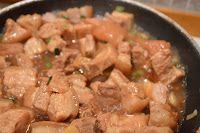Being a food blogger I'm used to winging it. You know, tossing stuff into the pan (occasionally by accident) and hoping for the best. So, following a recipe point by point can be quite... liberating. Though strangely challenging too. But how else is one going to judge a book and its recipes? By its cover...?
If the recipe in question comes from a source as revered as Gordon Ramsay, there shouldn't be anything to fear, right? I received this book (originally World Kitchen, 2009) with mixed feelings. Now, my kitchen and blog have been making culinary travels around the world; discovering new things and nurturing memories brought back from my own travels. Yet I have reservations about any book or a restaurant that claims to be specialized in all cuisines of the world.
I tend to appreciate books that focus on a certain area; introducing its special features, typical ingredients, cooking methods and history more than just scratching the surface. Once you've got the hang of the balance and the factors contributing to it, sure, make it your own.
World Kitchen on the other hand offers a minibreak to France, Italy, Greece, Spain, Great Britain, Middle East, China, Thailand, India and United Stated (pheeeeeew). As such it's probably more suited for someone whose cook book arsenal has no immediate plans to take over their bedroom too. But I do have a feeling the face and name of the Glaswegian tiger probably account for more than the actual content.
First impression is very.. bland. I don't know how Mr. Ramsays rage, so familiar from his TV performances would even translate onto the pages of a cook book (though I am fairly certain it wouldn't sell very well!). The book just seems a bit - I don't know - lackluster? Introduction to the dishes chosen for this book has been kept to an absolute minimum and the book is lacking sort of a personal touch. The overall appearance (or photos that are so important to me) fails to evoke any excitement. Sure, the photos are large and good quality but not the kind that would evoke ideas and create and atmosphere. There's certain genericness about it that reminds me of the first cook books I ever remember reading back in the 80's.
For the trail recipe I picked "red braised pork belly" from Chinese section. It's also one of the few recipes the author himself recommends one tries. And off we went...
Excitement was soon replaced by scepticism. Based on the picture the end result should be reminiscent of the caramelized pork that Farang, champion of South East Asian cooking and one of my favourite restaurants in Helsinki, has given a bit of a cult status. The method and the ingredients however don't seem to add up. There seems to be too little of everything: spices, quantities and cooking time. In Farang's recipe for caramelized pork one first makes the broth in which the pork is subsequently cooked in for hours. After that both pork and broth are chilled overnight (separately and the pork with a little weight on top of it) after which the pork is then deep fried and served with a thick sauce that has been reduced from the stock (this stage alone takes over an hour).
 |
| Tässä Gordonin possu... |
This marathon takes one to the finish line a lot quicker. A lot. First you boil the meat for a couple of minutes, then you chop it up, caramelize the cubes (again for only a few minutes) and then you cook the pork in liquid that you're then supposed to reduce it to thick, syrupy sauce. Having attempted to recreate the photo above twice now I doubt there will be a third try. First attempt resulted in a charred, rock-hard stinking mess, though the colour was pretty spot on. Next time I kept watching the liquid evaporating as if my life (and not just my sanity and any credentials as a food blogger) depended on it, but there really wasn't anything to reduce. And the colour came from a completely different Pantone chart - there was none of that dark, deep richness.
I don't consider myself totally clueless in the kitchen, but even to my eyes the recipe seems a bit nonchalant. First the recipe talks about a pan, but later mentions a pot. Though I can't imagine what kind of a pot would accommodate and caramelize that kind of amount of meat. There was no mention of whether the pot/pan should be kept covered in the simmering phase. With a lid on it wouldn't really reduce terribly well, but without the lid the liquid evaporates in moments. In any case the recipe calls for 2 dl of water, which is in no way enough to cover the ingredients as one is instructed to do - what ever the cooking vessel. Did they perhaps mean 2 l? I'll never know.
A quick foray into the wonderful world of fellow food bloggers revealed their takes on the recipe had nothing on the original one either. Colour-wise that is (click on the photos to be redirected).



And I don't know what sort of Victoria Beckhams Gordon's used to feeding - I'd say the recipe feeds 3-4 people. At most.
Serves 4-6
800 g boneless pork belly (with the skin still on)
1 tbsp vegetable oil
2 tbsp caster sugar
3 tbsp light soy sauce
3 tpsb dark soy sauce
3 cm piece fresh ginger, peeled and cut into thick slices
2 star anises
1 cinnamon stick
3 dried chillis
about 2 dl water
3 spring onions, chopped
Bring a wide pan or water to boil and reduce the heat a bit. Lower the pork into the pot (cut in two if needed) and let boil for 3-4 minutes. Peel the foam that collects onto the surface which there will be a lot of (editor's note: there was none). Drain the meat and let cool for a bit. Wipe the pot clean and put back on heat.
Cut the pork into 2 cm cubes. Heat oil and sugar in a pan over medium heat. As soon as the sugar has dissolved and starts caramelizing, add meat into the pan skin side down. Fry for a couple of minutes until the skin starts caramelizing ("until the skin starts to caramelize"? In case you really want to meat to get any real colour, multiply that time by at least 5 - it won't have chance to brown at later stages either).
Add soy sauces, ginger, star anise, cinnamon stick and dried chillis into the pan and pour enough water to just cover the ingredients (2 dl? Really? Mine took at least 5 times that). Bring to boil and let simmer (quietly so) for 50-60 minutes until the meat is very tender (it's not melt-in-your-mouth-tender-loving sort of done by this time).
Using a slotted spoon, lift the meat out of the pan onto a plate. Reduce the remaining liquid until its thick and syrup-like (had I followed the recipe to a tee I would only have been left with a couple of spoonfuls). Check seasoning and add a pinch of sugar if it's too salty for you. Stir in the spring onions (reserving a handful for serving) and return the meat into the sauce. Heat for a while.
Divide the food into heated serving dishes, decorate with the remaining spring onions and serve immediately.
 |
| ...ja tässä ruokabloggarin. |
And the final verdict? After the initial frustration I'm feeling a lot more mellow. If you're more generous with liquid, keep the simmer to low, keep the pan partly covered and perhaps crank the spices up a notch, this is good. And in any case - takes a lot less time than the elusive Farang pork...
I also got feeling a little bad about trashing the book, too. What if that book is to Gordon what this blog is to me? A selection of precious memories I've picked up along the way? A random (and occasionally rambling) collection of some of my favourite things (hands up if you didn't just start humming and channeling your inner Julie Andrews)? I really ought to give the book another go, shouldn't I? I mean, the man has some serious street cred. Perhaps I'll give rabbit ragu a go. Or Mississippi mud cake...?
The theme in Finnish food blogger's monthly food challenge this month is chilli. I have warm memories of last January's challenge where the theme was chilli, too. My blog, which had just seen the daylight two weeks earlier took part with coconut prawns and mango-chilli dip and won! I have high hopes for this month's challenge too - you are looking at our contender! Stay tuned for information as to where, when and how to vote!
* The book was received for free for reviewing purposes *
_____________________
ANYONE FOR SECONDS?

















































